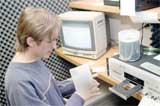New video CDs preserve deteriorating tapes

Noah Anderson, senior graphics major, finishes transferring several old interviews from 3/4-inch U-matic tape to a video CD in the editing room of KGCS on Feb. 1.
One television station is working to preserve its heritage.
KGCS-LP has been a fixture at Missouri Southern for several years. During this time, the station has collected an archive of interviews. Time has begun to take its toll on the technology that recorded these programs.
“The physical video tape is not lasting forever; they are over 20 years old now,” said Judy Stiles, general manager of KGCS. “So we try to preserve what people had to say. There is a lot of moral history we think we need to save.”
These tapes include interviews with many faculty members who have either left the University or died.
“What we started with was a series they had back when they started the station, in the early 1980s, called Southern Perspective,” Stiles said. “And at that time they were one-hour interviews with people who not only were faculty members on campus, but were influential in starting the campus and so forth.”
The format used is the cause of the deterioration of the tapes. The tapes, no matter what their quality, eventually break down through a process of oxidation.
“If you pull a tape out, a VHS, a digital tape and audio tape, it is brown,” said Bill Hunt, creative services director for KGCS. “So if you pull out and look at it, that brown stuff is the oxide on the tape that contains the tiny particles of metal that the actual recordings are on. Well, that just starts to deteriorate.”
In order to preserve the shows, the station has started copying the shows onto CD format. Since the CD is read optically, there is no wear on it as seen with tapes. Still this is a risky process for the station because of the problems associated with oxidation.
“Well when you take a tape, three-quarter-inch tape, from the 80s and put it in a three-quarter-inch video tape machine to play it back, the oxide is rubbed off of the tape and it collects on the video heads,” Hunt said. “And then within just a few minutes it clogs the heads, and it won’t play. So each time you put the tape in there you are effectively ruining a portion of the tape.”
When the restoration process is finished, the KGCS archive will be in a format that should hold up for many years to come without wear from time.
Your donation will support the student journalists of Missouri Southern State University. Your contribution will allow us to purchase equipment and cover our annual website hosting costs.



























